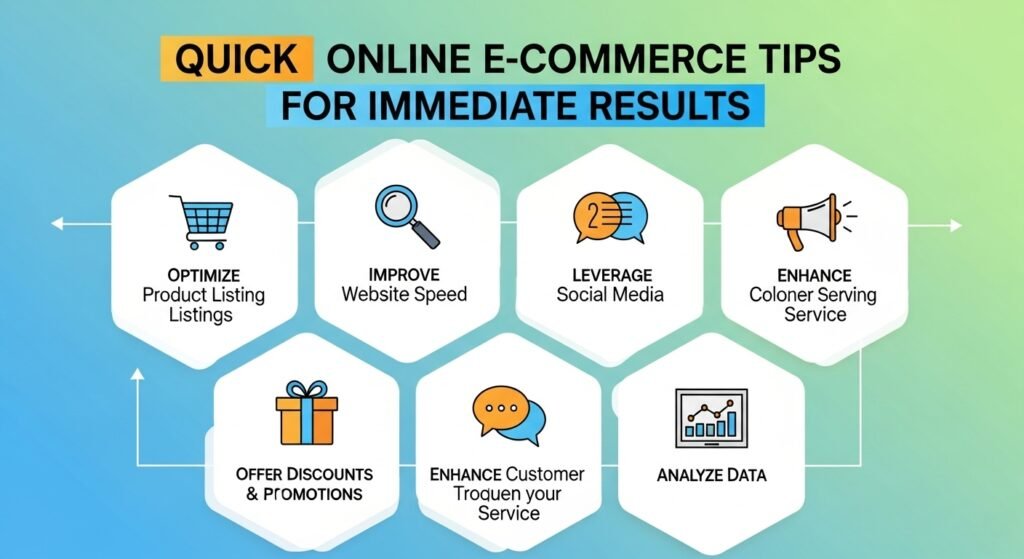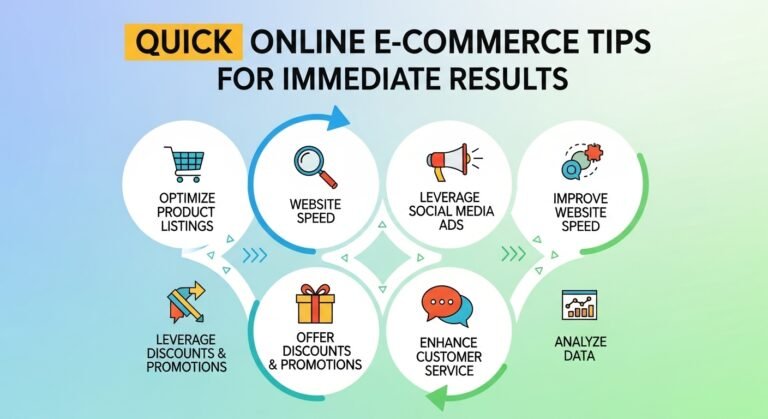Running an online store can feel like an uphill climb, especially when you want results right away. Whether you’re just starting out or trying to push your existing store forward, small but smart actions can make a big difference. In this guide, you’ll find a complete set of quick online ecommerce tips you can start using today to drive traffic, increase sales, and build customer loyalty. Everything here is practical, straightforward, and designed for immediate impact.
Understanding Google’s Latest Updates and AI Overview
Before diving into ecommerce strategies, it’s worth understanding how Google’s latest spam and AI-related updates affect your store and content.
Over the last year, Google has doubled down on rewarding high-quality, human-centric content while reducing the visibility of low-value, repetitive, or mass-produced material. The company’s goal is simple: give users the most relevant and helpful results. Auto-generated content that offers little originality or insight now risks being flagged as “scaled content abuse.”
This doesn’t mean AI is bad or forbidden. In fact, Google acknowledges that AI can help businesses create content efficiently. What matters most is how you use it. If you rely on tools to create ideas or structure your content but still add personal insights, experiences, or expert commentary, your work remains valuable. On the other hand, simply publishing generic, unedited AI text could lead to lower visibility in search results.
So, as you apply these quick online e-commerce tips, remember to personalize everything. Let your brand voice, product expertise, and unique perspective shine through. That human element is what keeps you aligned with Google’s latest quality standards and helps you stand out in a crowded online marketplace.
Quick Online E-commerce Tips You Can Try Right Now
These practical ideas are grouped into four key areas: traffic, conversion, customer retention, and optimization. You don’t need to implement them all at once—just start with a few that fit your current goals and resources.
Traffic Boosting Tips
1. Partner with Micro or Nano Influencers
Big-name influencers can be expensive, and their audiences aren’t always the most engaged. Instead, work with smaller creators in your niche who have loyal followers. Offer them free samples or special discounts in exchange for honest reviews or short videos. These smaller partnerships often bring more authentic engagement and quicker sales.
When you do this, give influencers a special discount code to track sales. Encourage them to create stories, reels, or unboxing videos instead of static posts. Genuine enthusiasm and relatability make a stronger impression than a scripted endorsement.
2. Turn Existing Content into Paid Ads
Look at your best-performing social posts or customer reviews and repurpose them as ads. If something already gets great engagement, it’s a safe bet that a similar audience will respond well too. This saves time on creating new ad content and helps your campaigns perform better from the start.
3. Use Real-Time Scarcity and Urgency
Adding real-time notifications such as “Only three left in stock” or “Sale ends soon” can prompt faster decisions. People naturally respond to limited availability. However, make sure these alerts are truthful. Fake scarcity damages trust and can lead to long-term harm for your brand.
4. Try a Short Flash Sale
Flash sales are a classic way to spike sales quickly. Announce a one-hour or two-hour sale through email and social media, offering a noticeable discount. Use countdown timers or banners to emphasize urgency. Even a small burst of activity can reignite interest in your products and attract new customers.
Conversion and Checkout Tips
5. Simplify Customer Choices
When shoppers face too many options, they hesitate. Simplify your product pages by highlighting your best sellers or most popular variations first. Make it easy to add items to the cart without requiring too many clicks. Fewer decisions often lead to faster purchases.
6. Add Urgency During Checkout
Encourage faster checkouts with small visual reminders like shipping deadlines or delivery cutoffs. A simple message such as “Order within the next two hours for same-day dispatch” can make a difference. Include trust badges and progress bars to reassure customers that checkout is safe and straightforward.
7. Enable One-Click Payment Options
Make buying easy by adding options like PayPal, Apple Pay, or Google Pay. Returning customers appreciate not having to fill out the same details every time. A smooth, one-click checkout can significantly reduce abandoned carts.
8. Use Exit-Intent Popups to Recover Sales
When someone moves their mouse toward the back button or close tab, trigger a small popup offering a last-minute incentive—like a discount or free shipping. Keep the message friendly and short, such as “Wait! Enjoy 10% off if you complete your order now.” It’s a simple and effective way to capture lost sales.
Retention and Repeat Sales Tips

9. Add Post-Purchase Offers
After someone completes a purchase, use the thank-you page to suggest related products at a discounted price. For example, if they bought a camera, offer a memory card or lens cleaning kit at half price. Buyers are more likely to add small, relevant extras when they’re already in shopping mode.
10. Send Follow-Up Emails with Rewards
Within a few hours of a customer’s first order, send a thank-you message that includes a coupon for their next purchase. Make it valid for a limited time to encourage repeat buying. A short note like “A small thank-you for shopping with us” feels personal and builds goodwill.
11. Introduce a Simple Referral Program
Offer incentives for referrals. Give customers a discount or reward for every friend who makes a purchase through their link. The friend can also receive a small discount. This encourages organic word-of-mouth promotion and builds a loyal customer base over time.
Optimization and Technical Tips
12. Check Site Speed and Mobile Experience
Slow websites cost you sales. Use tools like Google PageSpeed Insights or GTmetrix to identify issues. Compress large images, reduce unnecessary scripts, and make sure your site loads quickly on mobile devices. Since many shoppers buy from their phones, a smooth mobile checkout process is essential.
13. Highlight Social Proof and Customer Content
Display customer photos, star ratings, and reviews directly on your product pages. Real-life testimonials are far more convincing than generic descriptions. You can also show real-time activity, such as “20 people bought this item today,” to reinforce popularity and trust.
14. Test One Change at a Time
Run A/B tests regularly to refine your site. Change one element—like a button color, headline, or call-to-action—and compare results. Small adjustments can lead to meaningful improvements over time. Keep testing and learning from customer behavior.
15. Improve Internal Search and Filtering
Many visitors use your store’s search bar to find products. Make sure it’s prominent, accurate, and fast. Include auto-suggestions and filters for price, size, or color. A better search experience keeps customers engaged instead of leaving out of frustration.
A 30-Day Plan for Quick E-commerce Wins
You can apply these quick online e-commerce tips in a short sprint and see measurable progress within a month.
Days 1–3: Focus on quick wins like flash sales, influencer collaborations, and urgency-based promotions.
Days 4–7: Improve the checkout experience by simplifying options and adding express payment choices.
Days 8–14: Strengthen retention with thank-you emails, coupons, and referral programs.
Days 15–21: Optimize performance by testing site speed and refining your mobile layout.
Days 22–28: Run small A/B tests on product pages and scale the campaigns that perform best.
Days 29–30: Review your analytics. Look at conversion rates, average order value, and ad performance. Keep what works and adjust what doesn’t.
This structured, short-term approach helps you stay organized while creating visible improvements.
SEO and Content Enhancements You Can Do Quickly
Not all SEO takes months to pay off. Here are a few fast fixes that can improve visibility almost immediately.
Optimize Titles and Meta Descriptions
Make sure your product titles are descriptive and naturally include important keywords. Write meta descriptions that highlight value and encourage clicks, like “Shop eco-friendly candles made from natural soy wax. Free shipping on all orders over $40.”
Add Schema Markup
Structured data helps Google understand your content better. Use product, review, and FAQ schema to make your listings more appealing in search results. Many ecommerce platforms already have built-in tools to help with this.
Create Helpful Mini-Blogs or Guides
Answer specific customer questions with short, useful articles. For example, a skincare store might post “How to Layer Serums and Moisturizers.” These pieces can attract search traffic and direct readers to related products.
Strengthen Internal Linking
When you write blog posts or guides, link naturally to your best-selling products or key category pages. This keeps visitors moving through your site and helps search engines connect related content.
Remove Duplicate or Thin Pages
If your site has multiple similar pages or product duplicates, consolidate them to improve your site’s organization. This focuses your SEO strength on the most valuable pages, rather than spreading it too thin.
Cancolussion
Growing an e-commerce business doesn’t always require big campaigns or long timelines. Sometimes, all it takes is a few focused actions that create momentum quickly. These quick online ecommerce tips are designed to give you that momentum—from improving your checkout flow to optimizing your website speed and engaging your audience in more meaningful ways.
Remember that success comes from consistent testing and real human input. Use automation and AI where it makes sense, but always add your experience, personality, and brand story to everything you publish. That’s what sets you apart from competitors and aligns you with Google’s evolving expectations.



